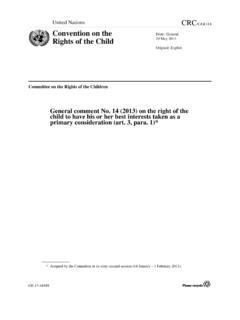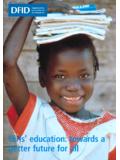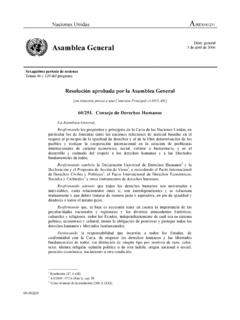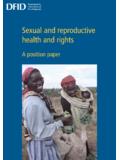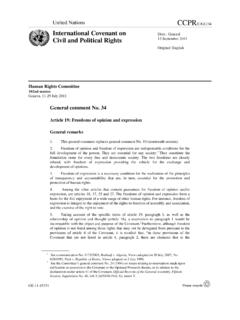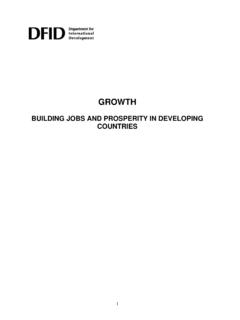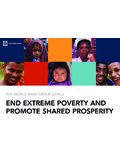Transcription of policy Reducing poverty by tackling social exclusion
1 Reducing poverty by tackling social exclusionA DFID policy paperpolicyCover photo: A Karen Burmese refugee boy in the remnants of the Huay Kalok refugeecamp near Mae Sot, Thailand. The camp was subjected to a night-time flamethrower attackby members of an ethnic Karen splinter group, resulting in a number of casualties and thedestruction of over 1000 dwellings. ( Paula Bronstein/Liaison/Getty Images) Reducing poverty by tackling social exclusionA DFID policy paperPublished by the Department for International DevelopmentSeptember 2005iiPeople need the opportunity to participate fully in the life of their community if they are to flourish and realise their potential. But certain groups in society are systematically excluded from opportunities that are open to others, because they are discriminated against on the basis of their race, religion, gender, caste, age, disability, or other social who are excluded like this are not just like the rest of the poor, only poorer.
2 They are alsodisadvantaged by who they are or where they live,and as a result are locked out of the benefitsof development. social exclusion deprives people of choices and opportunities to escape frompoverty and denies them a voice to claim their exclusion is often a cause of poverty , conflict and insecurity. If we are to tackle it effectively,we need to recognise where it is a problem, understand it better and, where appropriate, finddifferent ways of working with partner governments, the international community and civil societyorganisations to overcome Department for International Development (DFID) is already supporting a variety of activities totackle exclusion . Good work has been done, particularly in Latin America and Asia. In Africa, socialexclusion is also a growing challenge, highlighted by the African Union, the New Partnership forAfrica s Development (NEPAD) and the Commission for Africa.
3 Our civil society partners are alsodoing an enormous amount to give excluded groups a voice, to ensure their participation in povertyreduction programmes and to build social movements that demand stronger paper sets out how DFID will build on the work that is already under way. It sets out somepractical actions that DFID is taking to tackle social exclusion and make a real difference to the livesof excluded Thomas MPParliamentary Under-Secretary of State for International DevelopmentiiiForewordivPageForewordiiiE xecutive summary11. Who is socially excluded and why this matters3 How do people become excluded?3 social exclusion causes poverty5 social exclusion makes it harder to achieve the Millennium Development Goals6 social exclusion leads to conflict and insecurity82. What public policy can do to reduce social exclusion9 Legal, regulatory and policy frameworks9 Budgets and public expenditure9 Economic opportunities and access to services10 Promoting participation and protecting people s rights11 Costs and benefits123.
4 What civil society can do to reduce social exclusion13 Increasing accountability and promoting the rule of law13 Influencing policymaking13 Delivering services where the state will not14 tackling prejudice and changing behaviour144. What donors can do to help reduce social exclusion16 Should exclusion be a high priority in our country programmes?16 Information and analysis17 Policymaking and budgets17 policy implementation and monitoring18 policy dialogue and conditionality19 Human rights and domestic accountability19 Piloting innovative approaches20 Direct service delivery to excluded groups205. What DFID will do to help reduce social exclusion21 Endnotes22vContentsvi1 There are groups of people in all societies who are systematically disadvantaged because they arediscriminated against. Discrimination occurs in public institutions, such as the legal system or theeducation and health services, as well as in the household and in the , women and children who are discriminated against often end up excluded from society, theeconomy and political participation.
5 They are more likely to be poor. They are more likely to be deniedaccess to income, assets and services. These people suffer from social exclusion and povertyreduction is harder as a reduction policies often fail to reach socially excluded groups unless they are specificallydesigned to do so. This paper is about the challenges posed by social exclusion , and the waysgovernments, civil society and donors can help to tackle them. These include: creating legal, regulatory and policy frameworks that promote social inclusion; ensuring that socially excluded groups benefit from public expenditure as much as other groups; improving economic opportunities and access to services for excluded groups; promoting their political participation in society, and their capacity to organise and mobilisethemselves; increasing accountability to protect citizens basic human rights; and tackling prejudice and changing also recommends ways in which DFID can do more in this area, including stepping up its efforts to: analyse the impact of exclusion on poverty reduction in all our country programmes, in order todecide priorities for work by region, country and sector; promote exchanges of best practice between national and regional organisations.
6 Work with other government departments and development partners to include analysis of exclusion as a cause of conflict and insecurity in our approaches and responses to conflictprevention and reduction; identify opportunities to address social exclusion in fragile states; strengthen the collection and analysis of statistics on excluded groups; work with the World Bank and regional development banks, United Nations agencies, theEuropean Community and other donors to make development work better for excluded groups;Executive summary2 Reducing poverty by tackling social exclusion increase the inclusiveness of our own human resources practices and strengthen the diversity inour workforce; commission new research and ensure adequate attention is paid to exclusion , inequality andrights in all our research on natural resources management, HIV and AIDS, education and otherrelevant areas; broaden and deepen our engagement with civil society to strengthen the contribution it canmake to tackling exclusion ; and be accountable for implementation of the policy set out in this paper by evaluating progress in is socially excluded and why this matters 13 Many women and girls are socially excluded.
7 So are people who are discriminated against on thebasis of age, caste, descent, disability, ethnic background, HIV or other health status, migrant status,religion, sexual orientation, social status or where they all societies some groups are socially excluded. However, the groups affected and the degree ofdiscrimination vary from one society to another, as do the forms that social exclusion takes. In onecontext discrimination against women may pose the greatest development challenge; in another itmight be racial discrimination. And people who suffer discrimination on various fronts for instancedisabled older women from ethnic minorities are often the do people become excluded?In order to tackle social exclusion it is important to understand the processes by which people areexcluded. People are excluded by institutions and behaviour that reflect, enforce and reproduceprevailing social attitudes and values, particularly those of powerful groups in this is open and deliberate, such as when state institutions deliberately discriminate intheir laws, policies or programmes.
8 In Lesotho, for example, women have until recently beendisadvantaged through the law. They could not inherit land or property, get a job or sign a contractwithout the permission of their husbands. In Pakistan, the evidence in court of a Muslim woman isworth half that of a man. In many countries, certain state benefits are denied to non-citizens,leaving them vulnerable to destitution. In other cases there are rigid social systems that decidepeople s position in society on the basis of heredity, as in the South Asian caste often, institutions perpetuate exclusion unofficially. Public sector workers who reflect theprejudices of their society may institutionalise some kinds of discrimination. In many Indian schools,for example, teachers expect Dalit children to do menial tasks such as cleaning the is social exclusion ? social exclusion describes a process by which certain groups are systematicallydisadvantaged because they are discriminated against on the basis of their ethnicity, race, religion, sexual orientation, caste, descent, gender, age, disability,HIV status, migrant status or where they live.
9 Discrimination occurs in publicinstitutions, such as the legal system or education and health services, as well associal institutions like the is frequently more subtle and unintentional, for example when disabled people areexcluded from services, markets and political participation through a lack of awareness of their needsor by social attitudes, or when minority groups are excluded by language barriers. In addition, theresulting sense of powerlessness can rob people of their self-confidence and aspirations and theirability to challenge aspect of exclusion is disadvantage on the basis not of who you are but where you live,known as spatial exclusion . People who live in remote and isolated areas may be prevented fromfully participating in national economic and social life. People from the wrong part of town can findit harder to get a job because of the social stigma that can be attached to the places of the poor (for instance, the favelasof Brazilian cities).
10 And people who move from one part of a country toWhen people feel they are being judged on the basis of who they are, they mayperform less well. When people expect prejudice, it can undermine their motivationto achieve. A study in Uttar Pradesh, India, illustrates this and shows how self-esteemcan affect performance in study tested high-school students drawn equally from scheduled and high-castebackgrounds. The children were asked to solve a maze problem. Some children didthe test in mixed groups and their castes were concealed. Others did the test in theircaste grouping, which was announced publicly. For the former, there was nodifference in performance between caste groupings. But for those students whosecastes were revealed, there was a statistically significant difference, even when theindividuals backgrounds were taken into account. I got HIV from my husband.

